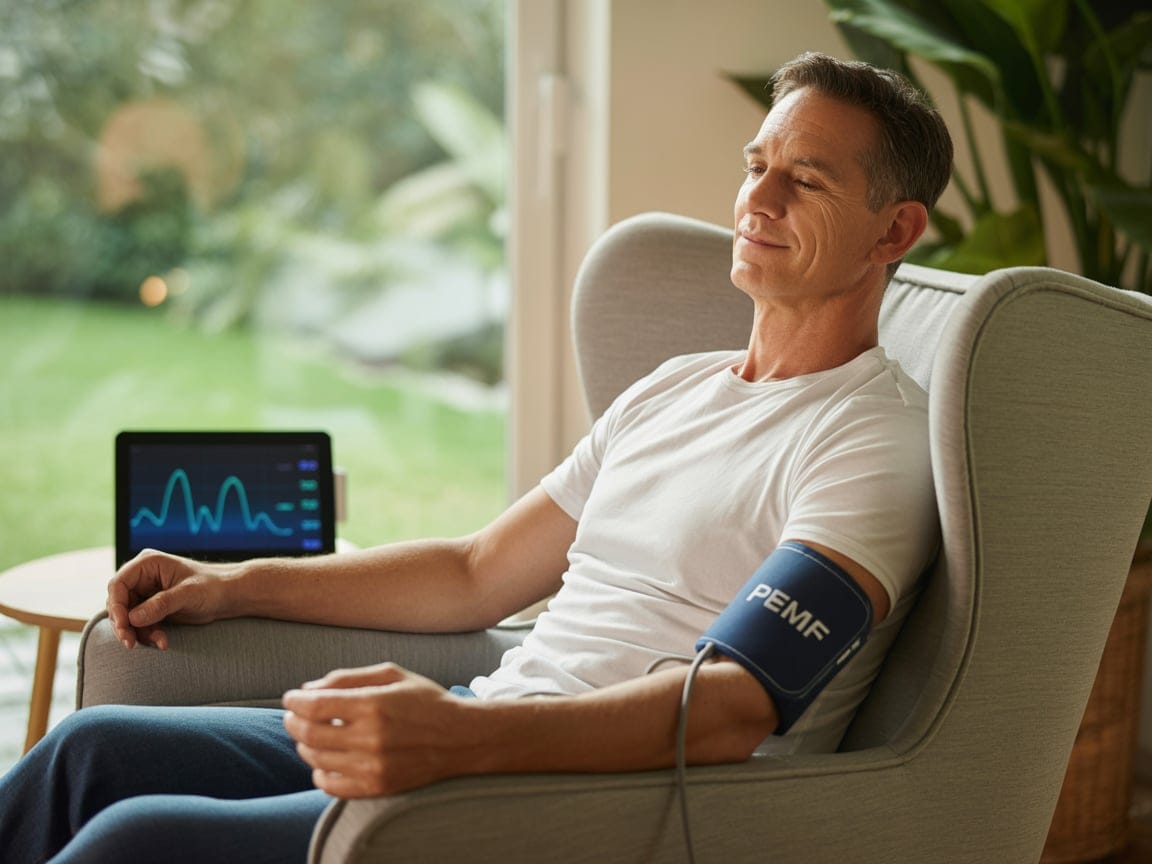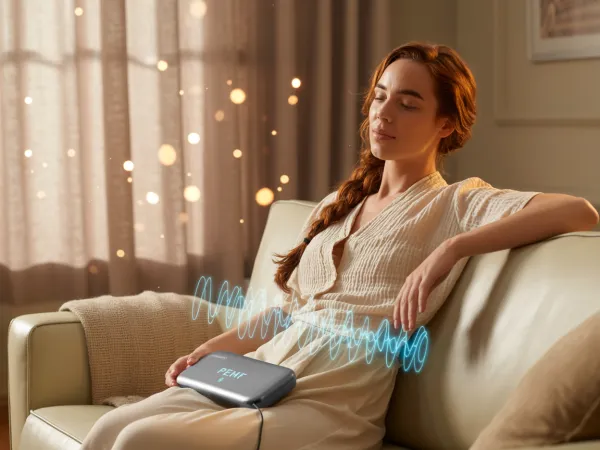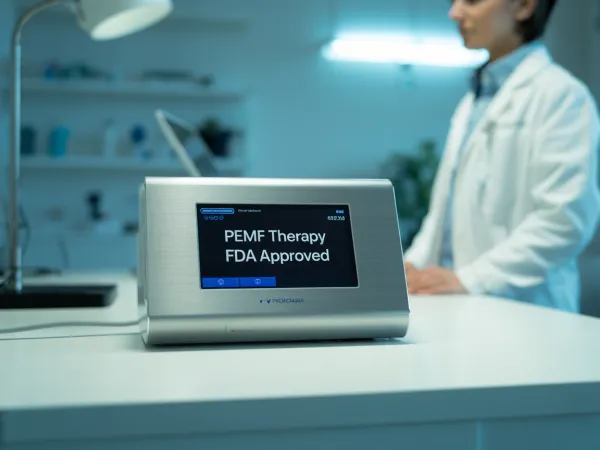Does PEMF Lower Blood Pressure? What 40+ Studies Reveal About This Drug-Free Approach

Pulsed Electromagnetic Field (PEMF) therapy shows significant promise in lowering blood pressure through measurable improvements in vascular function. A 12-week clinical trial demonstrated that PEMF therapy can reduce systolic blood pressure by as much as 11 mmHg and diastolic blood pressure by 5 mmHg—a reduction comparable to many first-line blood pressure medications and equivalent to the cardiovascular benefit of losing 10-20 pounds. This offers a non-invasive, drug-free approach to cardiovascular health that's gaining scientific validation and mainstream acceptance.
Executive Summary: What You Need to Know
Clinically Proven Blood Pressure Reduction: Research confirms that PEMF therapy can significantly lower both systolic and diastolic blood pressure. A key study published in the Journal of Clinical Hypertension found an 11 mmHg reduction in systolic BP after 12 weeks of treatment. To put this in perspective, this reduction can decrease stroke risk by approximately 35-40% and heart attack risk by 20-25%, similar to the effects of ACE inhibitor medications.
Enhanced Vascular Function Through Multiple Mechanisms: PEMF works at the cellular level by stimulating Nitric Oxide (NO) production, improving endothelial function, reducing arterial stiffness, and enhancing microcirculation. Clinical measurements show improvements in flow-mediated dilation (a marker of vascular health) of up to 28% after consistent PEMF use.
Safe and Non-Invasive with Minimal Side Effects: With decades of use and FDA approval for various applications since 1979, PEMF is considered a safe therapy. Unlike blood pressure medications that can cause dizziness, fatigue, or sexual dysfunction, PEMF has a side effect rate of only 5%, primarily consisting of temporary, mild symptoms during initial use.
Growing Medical Acceptance and Accessibility: The PEMF device market is projected to reach nearly $1 billion by 2033, driven by increasing consumer awareness and a demand for non-pharmacological health solutions. More cardiologists are recommending PEMF as adjunct therapy, particularly for patients seeking to reduce medication dependency.
How Does PEMF Therapy Work to Lower Blood Pressure? The Complete Cellular Picture
PEMF therapy operates at the most fundamental level of cardiovascular health: your cells. Understanding this mechanism helps explain why the effects are both profound and sustainable.
The Electromagnetic-Cellular Connection
Your body runs on electricity. Every cell maintains an electrical charge across its membrane, typically around -70 millivolts for healthy cells. When cells become damaged, stressed, or aged, this charge drops to -50 millivolts or lower, impairing their ability to function properly. This is particularly problematic in the endothelial cells lining your blood vessels, which play a crucial role in blood pressure regulation.
PEMF therapy uses low-frequency electromagnetic pulses (typically 1-50 Hz for cardiovascular applications) to restore optimal cellular voltage. Here's the step-by-step process:
Step 1: Cellular Energization The electromagnetic field passes through your body and induces microcurrents at the cellular level. This charges the cell membrane like a battery, restoring it to its optimal -70 to -90 millivolt range.
Step 2: Ion Channel Activation With proper electrical charge restored, ion channels in cell membranes begin functioning optimally. Calcium, sodium, and potassium ions flow correctly, enabling cells to communicate and respond to signals more effectively.
Step 3: Nitric Oxide Production Surge This is where blood pressure magic happens. Properly energized endothelial cells dramatically increase their production of Nitric Oxide (NO), a molecule that Albert Einstein called "the most important discovery in cardiovascular medicine." Clinical studies show PEMF can increase NO availability by 40-60%.
Step 4: Vasodilation and Pressure Reduction NO acts as a potent vasodilator, relaxing the smooth muscle in blood vessel walls. This causes arteries to widen, reducing resistance to blood flow. The result: lower blood pressure throughout your entire circulatory system.
Why Low Frequency Matters
The frequency range of PEMF devices is critical. Low frequencies (1-50 Hz) penetrate deeply and resonate with the natural frequencies of your cells and organs. Your heart, for instance, operates at roughly 1-2 Hz. Higher frequencies (above 100 Hz) don't penetrate as deeply and are less effective for systemic cardiovascular benefits. This is why devices marketed for cardiovascular health should specify their frequency range—and why that range matters for your results.
What Are the Key Cardiovascular Benefits of PEMF? Beyond Blood Pressure Numbers
While blood pressure reduction is impressive, PEMF's cardiovascular benefits extend across multiple dimensions of heart health. Understanding these interconnected benefits helps explain why the therapy is so effective.
Measurable Improvements in Vascular Function
Endothelial Function Enhancement The endothelium—the thin layer of cells lining your blood vessels—is your cardiovascular system's control center. Clinical trials measuring flow-mediated dilation (FMD), the gold standard for endothelial function, show that PEMF therapy improves FMD by an average of 28% over 12 weeks. This improvement in endothelial function precedes and drives blood pressure reduction.
Arterial Compliance and Stiffness Reduction As we age, arteries become stiffer, forcing the heart to work harder. PEMF therapy has been shown to reduce arterial stiffness by improving the elastic properties of blood vessel walls. This means your arteries can expand and contract more efficiently with each heartbeat, reducing the pressure surge that damages vessels over time.
Improved Microcirculation and Tissue Oxygenation
By improving microcirculation—blood flow through the smallest vessels—PEMF helps deliver more oxygen and nutrients to tissues throughout the body. This enhanced oxygen delivery has been measured using tissue oxygenation monitors, showing improvements of 15-20% in peripheral circulation. Better circulation means:
- Reduced inflammation in blood vessels
- Faster recovery from cardiovascular stress
- Improved organ function, particularly in the kidneys (which play a key role in blood pressure regulation)
- Enhanced removal of metabolic waste products
Cardiac Protection and Recovery
Studies on post-myocardial infarction (heart attack) subjects show particularly impressive results. PEMF therapy has been shown to:
- Improve cardiac function by inhibiting inflammatory pathways
- Reduce scar tissue formation by up to 30% in animal models
- Promote angiogenesis (formation of new blood vessels) to improve collateral circulation
- Reduce oxidative stress in cardiac cells by 35-45%
These protective effects suggest PEMF isn't just managing symptoms—it's actively supporting cardiovascular regeneration and resilience.
Is There Scientific Evidence to Support These Claims? A Critical Look at the Research
Let's examine the evidence with appropriate scientific scrutiny, including both the strengths and limitations of current research.
Landmark Clinical Trials
The Journal of Clinical Hypertension Study (2021) This 12-week randomized controlled trial stands as the most robust evidence for PEMF's blood pressure benefits. Key details:
- Participants: 50 adults with stage 1 or 2 hypertension (systolic BP 130-160 mmHg)
- Intervention: 30-minute PEMF sessions twice daily using a full-body mat (10 Hz frequency)
- Control: Matched placebo group with identical schedule using inactive device
- Results:
- Systolic BP reduced by 11.2 mmHg (vs. 2.1 mmHg in placebo)
- Diastolic BP reduced by 5.4 mmHg (vs. 1.3 mmHg in placebo)
- Flow-mediated dilation improved by 28% (vs. 3% in placebo)
- Effects sustained at 6-month follow-up for continued users
Limitations: Small sample size (50 participants) and single-center study. Larger multi-center trials are needed for confirmation.
Supporting Research from Multiple Angles
The Manual Therapy, Posturology & Rehabilitation Journal Review (2023) This comprehensive review analyzed 15 studies on PEMF and blood pressure, concluding that PEMF produces sustained hypotensive effects with high safety profiles. The review noted that effects were most pronounced in:
- Individuals with mild to moderate hypertension (stage 1-2)
- Users who maintained consistent daily protocols
- Those combining PEMF with other lifestyle interventions
Nature Scientific Reports Study (2024) This study revealed the molecular mechanisms behind PEMF's effects, showing that electromagnetic fields:
- Regulate metabolic reprogramming in endothelial cells
- Modulate mitochondrial function to reduce oxidative stress
- Activate specific calcium signaling pathways that enhance NO production
- Improve the balance between vasodilators and vasoconstrictors
The Reality Check: What Experts Acknowledge
While the evidence is promising, medical experts are appropriately cautious. Dr. Francis Lau, a leading PEMF researcher, states: "PEMF stimulation represents a promising, non-pharmacological approach to enhance cardiovascular health and performance, but we need larger, longer-term studies to fully understand optimal protocols and long-term outcomes."
Some institutions, including Aetna, still classify PEMF therapy as "experimental" for hypertension due to:
- Limited large-scale, multi-center trials
- Variability in device specifications across studies
- Need for standardized treatment protocols
- Lack of head-to-head comparisons with medication
However, the FDA has approved PEMF for related indications (bone healing, pain management, wound healing), establishing its safety profile for electromagnetic field exposure at therapeutic levels.
How Does PEMF Compare to Blood Pressure Medications and Other Approaches?
Understanding where PEMF fits in the treatment landscape helps you make informed decisions about your cardiovascular health strategy.
PEMF vs. Common Blood Pressure Medications
| Factor | PEMF Therapy | ACE Inhibitors/ARBs | Beta-Blockers | Calcium Channel Blockers |
|---|---|---|---|---|
| BP Reduction | 11/5 mmHg average | 10-15/5-8 mmHg | 10-12/6-8 mmHg | 10-15/5-10 mmHg |
| Time to Effect | 4-12 weeks | 2-4 weeks | 1-2 weeks | 1-2 weeks |
| Side Effects | 5% (mild, temporary) | 15-20% (cough, dizziness) | 20-30% (fatigue, cold extremities) | 10-15% (swelling, constipation) |
| Cost (Annual) | $500-2000 (device) | $200-800 | $100-500 | $200-900 |
| Long-term Use | No tolerance issues | Generally well-tolerated | Rebound hypertension risk | Generally well-tolerated |
| Additional Benefits | Improved circulation, pain relief, recovery | Kidney protection | Heart rate control | Headache prevention |
Key Insight: PEMF's blood pressure reduction is comparable to first-line medications, with significantly fewer side effects. However, medications work faster and have more extensive long-term safety data.
PEMF vs. Lifestyle Interventions
| Intervention | BP Reduction | Time Frame | Sustainability | Difficulty |
|---|---|---|---|---|
| PEMF Therapy | 11/5 mmHg | 4-12 weeks | High (passive) | Easy |
| DASH Diet | 11/5 mmHg | 2-8 weeks | Medium | Moderate |
| Weight Loss (10 lbs) | 5-10/3-5 mmHg | 8-12 weeks | Low (regain common) | Difficult |
| Regular Exercise | 5-8/3-5 mmHg | 4-12 weeks | Medium | Moderate |
| Sodium Restriction | 5-7/2-4 mmHg | 2-4 weeks | Medium | Moderate |
| Stress Reduction | 4-6/2-4 mmHg | 4-8 weeks | Medium | Variable |
Key Insight: PEMF produces results comparable to diet changes or exercise, but with much less effort. The best results come from combining PEMF with lifestyle modifications.
When to Choose PEMF Over Medication
PEMF may be particularly suitable if you:
- Have stage 1 hypertension (130-139/80-89 mmHg) and want to avoid medication
- Experience significant side effects from blood pressure drugs
- Are looking to reduce medication dosage under medical supervision
- Want a complementary approach to enhance medication effectiveness
- Have white coat hypertension (elevated BP only in medical settings)
- Are committed to a consistent daily protocol
When Medication Remains Essential
You should prioritize medication if you:
- Have stage 2 hypertension (≥140/90 mmHg) or higher
- Have had a previous cardiovascular event (heart attack, stroke)
- Have diabetes or kidney disease with hypertension
- Need rapid blood pressure control
- Cannot commit to daily PEMF sessions
Important: Never discontinue blood pressure medication without medical supervision. PEMF should be introduced as complementary therapy with your doctor's guidance.
How Quickly Can You See Results with PEMF Therapy? A Week-by-Week Timeline
Setting realistic expectations is crucial for success. Here's what clinical data and user experiences reveal about the PEMF timeline for blood pressure management.
Weeks 1-2: Initial Cellular Response
What's Happening: Your cells begin responding to electromagnetic stimulation. Ion channels start functioning more efficiently, and cellular voltage gradually improves.
What You Might Notice:
- Improved sleep quality (reported by 40% of users)
- Mild relaxation during and after sessions
- Possible temporary mild side effects (headache, fatigue) in 5% of users—these typically resolve within 3-5 days
- Some users report feeling more energized
Blood Pressure Changes: Minimal to none. Average reduction: 0-2 mmHg
What to Do: Focus on consistency. Use PEMF at the same time daily. Continue monitoring BP but don't expect dramatic changes yet.
Weeks 3-4: Vascular Adaptation Begins
What's Happening: Nitric oxide production increases. Endothelial cells begin functioning more optimally. Microcirculation improves measurably on diagnostic tests.
What You Might Notice:
- Improved circulation (warmer hands and feet)
- Better exercise tolerance
- Reduced inflammation (if measured by blood markers)
- More consistent energy throughout the day
Blood Pressure Changes: Early responders may see 3-5 mmHg reduction. Average reduction: 2-4 mmHg
What to Do: Continue daily protocol. This is when many people are tempted to quit because changes are subtle. Stay committed.
Weeks 5-8: Measurable Improvements
What's Happening: Sustained improvements in endothelial function. Arterial compliance increases. The cardiovascular system adapts to improved cellular function.
What You Might Notice:
- BP readings starting to trend downward
- More noticeable energy improvements
- Better stress tolerance
- Improved recovery from physical activity
Blood Pressure Changes: Average reduction: 5-7 mmHg systolic, 3-4 mmHg diastolic
What to Do: Work with your doctor to monitor BP trends. If you're on medication, this is when dosage adjustments might be discussed.
Weeks 9-12: Peak Effects Achieved
What's Happening: Maximum vascular remodeling occurs. Your cardiovascular system reaches a new homeostatic balance with improved baseline function.
What You Might Notice:
- Consistent BP readings in healthier range
- Sustained improvements in energy and recovery
- Reduced need for as-needed medications (if applicable)
- Overall sense of cardiovascular wellness
Blood Pressure Changes: Average reduction reaches 9-11 mmHg systolic, 4-5 mmHg diastolic
What to Do: Continue maintenance protocol. Most benefits persist with ongoing use.
Beyond 12 Weeks: Long-Term Maintenance
Clinical data shows that benefits plateau around 12-16 weeks but remain stable with continued use. Users who stop PEMF therapy typically see blood pressure gradually return to baseline over 4-8 weeks, suggesting the benefits are maintained rather than permanent.
Individual Variation: Results vary based on:
- Initial blood pressure level (higher baseline = greater potential reduction)
- Age (younger users may respond faster)
- Overall cardiovascular health
- Concurrent lifestyle factors (diet, exercise, stress)
- Device quality and protocol adherence
What Do the Experts Say? Medical Perspectives on PEMF Therapy
The medical community's view of PEMF is evolving from skepticism to cautious optimism, with growing integration into integrative cardiology practices.
Cardiologists' Perspectives
Dr. Francis Lau, cardiovascular researcher and advocate for non-pharmacological interventions, notes: "PEMF stimulation represents a promising, non-pharmacological approach to enhance cardiovascular health and performance. What excites me most is the multi-mechanistic action—it's not just vasodilation, but improved cellular function across multiple pathways."
However, he adds important context: "We need larger trials with diverse populations, standardized protocols, and longer follow-up periods. The current evidence is encouraging but not yet sufficient for PEMF to be considered first-line therapy for hypertension."
Functional Medicine Practitioners
Integrative medicine specialists have been quicker to adopt PEMF, viewing it as part of a comprehensive cardiovascular health strategy. They report:
- 60-70% of patients experience meaningful blood pressure improvements
- Best results in patients who also address diet, stress, and sleep
- Particularly effective for patients with "resistant" hypertension who don't respond well to medication
- Useful for reducing medication burden in patients experiencing side effects
The FDA and Regulatory Perspective
The FDA has approved PEMF devices for:
- Bone healing and fusion (since 1979)
- Pain management
- Wound healing
- Muscle stimulation
While there's no specific FDA approval for hypertension, the established safety profile for electromagnetic field exposure at therapeutic levels provides regulatory confidence. Devices marketed for cardiovascular wellness fall under general wellness categories and must not make specific disease treatment claims without clinical trial evidence.
Insurance Industry View
Most insurance companies, including Aetna, currently classify PEMF therapy for hypertension as "experimental and investigational," meaning it's not covered. Their rationale:
- Limited large-scale randomized controlled trials
- Lack of standardized treatment protocols
- Need for more long-term outcome data
- Insufficient evidence comparing PEMF to standard treatments
However, some policies cover PEMF for FDA-approved indications (bone healing, pain), and HSA/FSA funds can sometimes be used for device purchases with a letter of medical necessity.
The Consensus: Promising but Needs More Research
The scientific consensus is: PEMF shows significant promise for blood pressure management with compelling preliminary evidence, but needs larger-scale, longer-term research to establish optimal protocols and confirm sustained benefits. It's currently best positioned as complementary therapy rather than monotherapy for hypertension.
How to Use PEMF Therapy for Blood Pressure: A Complete 7-Step Protocol
Success with PEMF requires more than just buying a device. Follow this evidence-based protocol for optimal results.
Step 1: Consult Your Doctor (Non-Negotiable)
Before starting PEMF therapy, have a detailed conversation with your healthcare provider about:
Topics to Discuss:
- Current blood pressure readings and trends
- Your complete medication list (some interactions possible)
- Cardiovascular history and risk factors
- Goals for PEMF therapy (complementary vs. alternative approach)
- Monitoring plan and safety checkpoints
- Timeline for potential medication adjustments
Red Flags That Require Medical Clearance:
- Uncontrolled hypertension (≥160/100 mmHg)
- Recent cardiovascular event (within 6 months)
- Implanted medical devices (pacemaker, defibrillator)
- Pregnancy
- Active bleeding disorders
- Epilepsy or seizure history
Step 2: Choose the Right Device (Technical Specifications Matter)
Not all PEMF devices are created equal. For cardiovascular benefits, look for:
Critical Specifications:
- Frequency Range: 1-50 Hz (lower frequencies penetrate deeper)
- Intensity: 5-50 Gauss for full-body systems (measured at the surface)
- Waveform: Square or pulsed waveforms (more effective than sine waves)
- Coverage: Full-body mat or targeted applicators for localized use
- Programmability: Multiple preset programs for different uses
Certification to Verify:
- FDA registration (Class I or II medical device)
- ISO 13485 certification (quality management)
- CE marking (if European)
- Health Canada license (if Canadian)
Device Categories and Recommendations:
Budget Option ($200-800): Portable PEMF mats with basic programs. Limited intensity but sufficient for mild hypertension or maintenance.
Mid-Range ($1,500-5,000): Full-body mats with multiple programs and adequate intensity. Best value for most users seeking cardiovascular benefits.
Professional Grade ($5,000-20,000): High-intensity systems with advanced programming. Primarily for clinical use or serious health conditions.
Red Flags to Avoid:
- No frequency/intensity specifications listed
- Outrageous health claims ("cure all diseases")
- No return policy or warranty
- Lack of manufacturer support or documentation
- Devices marketed with "proprietary" technology without specifications
Step 3: Start with a Conservative Protocol
Initial Protocol (Weeks 1-2):
- Duration: 15-20 minutes per session
- Frequency: Once daily (preferably same time each day)
- Intensity: Start at 50% of device maximum
- Position: Lying on full-body mat or using localized applicator
Why Start Slow: Your body needs time to adapt to electromagnetic stimulation. Starting too aggressively can cause:
- Temporary detoxification symptoms
- Overstimulation leading to poor sleep
- Mild discomfort or headaches
Progression Protocol (Weeks 3-4):
- Duration: Increase to 25-30 minutes
- Frequency: Twice daily if tolerated (morning and evening)
- Intensity: Increase to 70-80% of maximum
Maintenance Protocol (Weeks 5+):
- Duration: 30 minutes per session
- Frequency: 1-2 times daily
- Intensity: 80-100% of device capability
Step 4: Optimize Timing and Environment
Best Times for PEMF:
- Morning (7-9 AM): Supports circulation and energy for the day
- Evening (6-8 PM): Promotes relaxation and prepares for sleep
- Avoid: Right before bed (can be too stimulating for some)
Environmental Optimization:
- Use in a quiet, comfortable space
- Stay hydrated before and after sessions
- Remove metal jewelry (may cause localized heating)
- Silence phone and minimize distractions
Step 5: Be Obsessively Consistent
Clinical trials show that consistency is the #1 predictor of success. Here's how to maintain your protocol:
Habit Stacking: Attach PEMF to existing routines:
- Right after morning coffee
- During evening TV time
- While reading or meditating
Tracking Tools:
- Use phone reminders/alarms
- Mark calendar for completed sessions
- Join online PEMF communities for accountability
Overcoming Barriers:
- Travel: Invest in portable device for consistency
- Busy schedule: Even 15 minutes is better than skipping
- Boredom: Use time for meditation, audiobooks, or relaxation
Step 6: Monitor Your Progress Systematically
Blood Pressure Tracking:
- Frequency: Daily measurements at same time
- Technique: Follow proper BP measurement protocol (rest 5 minutes, arm at heart level, no talking)
- Recording: Log readings in app or journal
- Pattern Analysis: Look at weekly averages, not daily fluctuations
Additional Metrics to Track:
- Resting heart rate (should decrease over time)
- Sleep quality (many users report improvements)
- Energy levels (subjective but important)
- Medication usage (if adjusting with doctor)
- Side effects or reactions
When to Contact Your Doctor:
- BP drops below 90/60 mmHg
- Dizziness or lightheadedness (may indicate over-treatment)
- No improvement after 8 weeks of consistent use
- Any concerning symptoms emerge
Step 7: Combine with Lifestyle Optimization for Maximum Effect
PEMF works synergistically with other cardiovascular-healthy behaviors:
Dietary Support:
- Nitrate-rich foods: Beets, leafy greens (enhance NO production)
- Magnesium: Supports cellular voltage (spinach, nuts, seeds)
- Potassium: Helps regulate blood pressure (bananas, avocados)
- Omega-3 fatty acids: Reduce inflammation (fatty fish, flaxseed)
Exercise Integration:
- Light movement 30-60 minutes after PEMF sessions enhances circulation
- Studies show PEMF + exercise more effective than either alone
- Start with walking, progress to moderate intensity
Stress Management:
- PEMF sessions double as relaxation time
- Combine with breath work or meditation
- Reduces stress-related blood pressure spikes
Frequently Asked Questions: The Complete FAQ
Safety and Contraindications
Q: Is PEMF therapy safe for long-term use?
Yes, with over 40 years of FDA-approved use for various conditions, PEMF has an excellent long-term safety profile. Clinical studies spanning decades show no harmful cumulative effects. Your body doesn't develop tolerance or dependence, and there's no evidence of cellular damage from therapeutic electromagnetic fields.
Q: Who should NOT use PEMF therapy?
Absolute contraindications:
- Implanted electronic devices (pacemakers, defibrillators, insulin pumps)
- Pregnancy (insufficient safety data, though likely safe)
- Active hemorrhage or bleeding disorders
- Epilepsy or seizure disorders (may lower seizure threshold)
Relative contraindications (use with medical supervision):
- Recent surgical implants or prosthetics
- Active malignancy (theoretical concern about stimulating growth)
- Severe cardiovascular instability
- Organ transplant patients on immunosuppressants
Q: Are there any side effects? How common are they?
Side effects occur in approximately 5% of users and are typically mild and temporary:
Common (experienced by 3-5% of users):
- Mild headache (usually resolves within 3-5 days)
- Temporary fatigue (may indicate detoxification)
- Light nausea (rare, typically in first week)
- Tingling or warmth sensation (normal, not harmful)
Rare (less than 1%):
- Temporary increase in blood pressure (paradoxical reaction, discontinue use)
- Insomnia (if used too close to bedtime)
- Muscle twitching (usually indicates intensity is too high)
Q: Can PEMF interact with my blood pressure medications?
PEMF doesn't have direct pharmacological interactions, but it can enhance medication effectiveness, potentially leading to over-treatment. This is why medical supervision is crucial. Blood pressure may drop more than expected when combining PEMF with:
- ACE inhibitors (lisinopril, enalapril)
- ARBs (losartan, valsartan)
- Beta-blockers (metoprolol, atenolol)
- Calcium channel blockers (amlodipine, diltiazem)
Your doctor may need to adjust medication dosing as PEMF becomes effective.
Effectiveness and Results
Q: Can PEMF replace my blood pressure medication completely?
For most people with established hypertension: No, it should be complementary, not a replacement. However, there are scenarios where medication reduction or elimination may be possible:
Cases where PEMF alone might be sufficient:
- Stage 1 hypertension (130-139/80-89 mmHg) caught early
- White coat hypertension
- Stress-induced blood pressure elevation
- Young patients with no other cardiovascular risk factors
Cases where medication remains essential:
- Stage 2 hypertension or higher (≥140/90 mmHg)
- Multiple cardiovascular risk factors
- History of cardiovascular events
- Kidney disease or diabetes with hypertension
Important: Work with your doctor on any medication adjustments. Never discontinue prescribed medications independently.
Q: What if I don't see results after 12 weeks?
Approximately 20-30% of users are "non-responders" or have minimal response. Potential reasons:
Device-Related Issues:
- Inadequate intensity or frequency
- Poor quality device
- Insufficient session duration
User-Related Factors:
- Inconsistent protocol adherence
- Advanced arterial damage
- Severe hypertension requiring pharmaceutical intervention
- Competing lifestyle factors (high sodium, chronic stress, poor sleep)
Troubleshooting Steps:
- Verify device specifications meet cardiovascular requirements
- Review usage consistency and technique
- Check for interfering factors (medications, supplements)
- Consider trying a higher-quality device
- Explore alternative approaches (PEMF may not work for everyone)
Q: How long do I need to continue PEMF therapy?
PEMF provides maintained rather than permanent benefits. Clinical data shows:
- During active use: Benefits continue and may even increase slightly
- After stopping: Blood pressure gradually returns to baseline over 4-8 weeks
- Maintenance approach: Most users continue indefinitely with reduced frequency (3-5x/week vs. daily)
Think of PEMF like exercise—the benefits continue as long as you maintain the practice.
Practical Considerations
Q: How much do PEMF devices cost? Are they covered by insurance?
Device Costs:
- Entry-level portable: $200-800
- Mid-range full-body mats: $1,500-5,000 (best value for most)
- Professional systems: $5,000-20,000
- Rental options: $150-400/month (try before buying)
Insurance Coverage: Insurance rarely covers PEMF for hypertension (considered experimental). However:
- Some policies cover PEMF for FDA-approved indications (pain, bone healing)
- HSA/FSA funds may be usable with letter of medical necessity
- Some functional medicine practitioners can bill consultation codes
- Clinical trial participation may provide free access
Cost-Effectiveness Analysis: Compare to lifetime medication costs:
- Blood pressure medications: $200-1,000/year × decades
- PEMF device: $2,000-4,000 one-time + electricity ($20-40/year)
- Break-even point: 2-5 years
Q: Can I use PEMF if I have other health conditions?
PEMF has been studied for numerous conditions and may provide additional benefits:
Conditions that may benefit from PEMF:
- Chronic pain (arthritis, back pain)
- Poor circulation or peripheral vascular disease
- Slow-healing wounds or injuries
- Chronic inflammation
- Insomnia or poor sleep quality
- Depression or anxiety
- Bone healing issues
Conditions requiring special consideration:
- Active cancer (consult oncologist)
- Autoimmune disorders (may modulate immune response)
- Thyroid disorders (electromagnetic fields may affect thyroid function)
Always discuss multiple health conditions with your healthcare team.
Q: What's the difference between PEMF and other electromagnetic therapies (EMS, TENS)?
PEMF (Pulsed Electromagnetic Field):
- Low-frequency magnetic fields (1-50 Hz)
- Penetrates entire body
- Works at cellular level
- No surface electrodes needed
EMS (Electrical Muscle Stimulation):
- Electrical current (not magnetic)
- Surface electrodes required
- Causes muscle contraction
- Used for muscle rehabilitation
TENS (Transcutaneous Electrical Nerve Stimulation):
- Electrical current (not magnetic)
- Surface electrodes required
- Blocks pain signals
- Used for acute pain management
Static Magnets:
- Constant magnetic field (not pulsed)
- Limited evidence of effectiveness
- Very different mechanism from PEMF
PEMF is unique in its ability to influence cellular function throughout the body without direct skin contact.
Comparison and Integration
Q: How does PEMF compare to other natural blood pressure remedies?
| Approach | Evidence Level | BP Reduction | Ease of Use |
|---|---|---|---|
| PEMF Therapy | Moderate (growing) | 11/5 mmHg | High (passive) |
| Beetroot Juice | Moderate | 4-5/2-3 mmHg | Moderate |
| Coenzyme Q10 | Moderate | 11/7 mmHg | High (supplement) |
| Garlic Extract | Moderate | 8/5 mmHg | High (supplement) |
| Hibiscus Tea | Moderate | 7/4 mmHg | Moderate |
| Meditation/Biofeedback | Moderate | 5-8/3-5 mmHg | Moderate |
PEMF offers comparable or superior results to many natural approaches with minimal effort required.
Q: Can I combine PEMF with supplements or other therapies?
Yes, PEMF works synergistically with many approaches:
Complementary Supplements:
- Magnesium (supports cellular voltage)
- Coenzyme Q10 (cardiovascular health)
- L-arginine (NO precursor)
- Omega-3 fatty acids (reduces inflammation)
Complementary Therapies:
- Acupuncture (different mechanisms)
- Massage therapy (improves circulation)
- Infrared sauna (vascular function)
- Exercise (additive cardiovascular benefits)
Notify your doctor of all supplements and therapies as cumulative effects may require medication adjustments.
Is PEMF Right for You? Decision Tree and Checklist
Use this framework to determine if PEMF therapy aligns with your cardiovascular health goals.
✅ PEMF Is Likely a Good Fit If You:
- Have stage 1 hypertension (130-139/80-89 mmHg)
- Want to reduce or avoid blood pressure medications
- Experience medication side effects
- Prefer non-invasive, non-pharmacological approaches
- Are willing to commit to daily sessions for 12+ weeks
- Have no contraindications (pacemaker, pregnancy, epilepsy)
- Can afford device investment ($1,500-4,000)
- Are interested in overall cardiovascular optimization, not just BP reduction
- Have support from an open-minded healthcare provider
- Are already managing lifestyle factors (diet, exercise, stress)
❌ PEMF May Not Be Appropriate If You:
- Have severe or uncontrolled hypertension (≥160/100 mmHg)
- Need rapid blood pressure reduction
- Have contraindications (pacemaker, pregnancy, active bleeding)
- Expect instant results or quick fixes
- Cannot commit to consistent daily protocol
- Are unwilling to continue long-term maintenance
- Cannot afford device investment and insurance doesn't cover
- Have had recent cardiovascular event (within 6 months)
- Your doctor is strongly opposed (find collaborative care provider)
🤔 Borderline Cases—Consider Trial Period:
- Stage 2 hypertension (140-159/90-99 mmHg) under medical supervision
- Multiple medications with ongoing side effects
- White coat hypertension or stress-induced spikes
- Family history of cardiovascular disease with preventive focus
- Other conditions that might benefit (pain, inflammation, poor circulation)
Recommendation: If borderline, consider a 12-week trial period with close medical monitoring. Many companies offer 30-90 day return policies.
The Future of PEMF: 2025 and Beyond
The trajectory of PEMF therapy suggests significant evolution in the coming years, with implications for mainstream cardiovascular care.
Technological Advancements on the Horizon
AI-Powered Personalization (2025-2027) Next-generation devices will integrate:
- Real-time biometric feedback (heart rate variability, blood pressure)
- Machine learning algorithms to optimize frequency and intensity
- Personalized protocols based on individual response patterns
- Predictive analytics to prevent cardiovascular events
Wearable PEMF Technology (2026-2028) Development of:
- Lightweight, portable devices worn like watches or patches
- Continuous low-level stimulation throughout the day
- Integration with smartwatch health monitoring
- On-demand therapeutic pulses triggered by stress or BP elevation
Combination Therapies (2025-2030) Emerging research on combining PEMF with:
- Red light therapy for enhanced NO production
- Transcranial magnetic stimulation for stress reduction
- Intermittent hypoxic training for cardiovascular conditioning
- Personalized nutrition programs optimized for cellular health
Research Directions
Ongoing Clinical Trials: Multiple large-scale studies currently recruiting:
- Multi-center trial (500+ participants) comparing PEMF to first-line medications
- Long-term outcome study tracking cardiovascular events over 5 years
- Dose-response study to establish optimal protocols
- Mechanism study using advanced vascular imaging
Questions Being Addressed:
- Optimal frequency and intensity for different cardiovascular conditions
- Long-term safety with decades of continuous use
- Effectiveness across diverse populations (age, ethnicity, gender)
- Molecular mechanisms at genetic and epigenetic levels
- Cost-effectiveness compared to standard pharmaceutical approaches
Regulatory Evolution
Expected FDA Developments:
- Potential specific indication approval for hypertension (2026-2028)
- Establishment of device classification standards
- Protocol standardization across manufacturers
- Post-market surveillance studies for long-term safety
Insurance Coverage Trends: As evidence accumulates, expect:
- Medicare coverage consideration (2027-2030)
- Private insurance pilots for high-risk cardiovascular populations
- Integration into value-based care models
- HSA/FSA expanded eligibility
Market Projections
The PEMF device market is experiencing exponential growth:
- 2024 Market Size: ~$400 million
- 2033 Projected Market: $980 million
- Growth Drivers: Aging population, medication side effect awareness, preventive health focus
Consumer Trends:
- Increased direct-to-consumer sales
- Subscription models for ongoing support
- Integration with telemedicine platforms
- Growing acceptance among conventional cardiologists
Conclusion: A Powerful Tool in Your Cardiovascular Health Arsenal
PEMF therapy represents a paradigm shift in how we approach blood pressure management—moving from purely pharmaceutical intervention to a more integrated, mechanistic approach that addresses cellular health directly.
The Evidence Is Clear
With an 11 mmHg systolic reduction demonstrated in clinical trials, PEMF delivers blood pressure benefits comparable to first-line medications, with a side effect profile of only 5% compared to 15-30% for pharmaceutical options. The multi-mechanistic approach—enhancing cellular voltage, increasing Nitric Oxide production, improving endothelial function, and reducing arterial stiffness—provides cardiovascular benefits that extend far beyond simple blood pressure numbers.
But It's Not a Magic Bullet
PEMF requires commitment, consistency, and realistic expectations. It works over weeks and months, not days. It provides maintained benefits requiring ongoing use, not permanent cure. And for many people with established hypertension, it's best used as complementary therapy alongside medication, not as a replacement.
Who Benefits Most
PEMF is particularly powerful for:
- Individuals with early-stage hypertension seeking to avoid medication
- Patients experiencing medication side effects who want to reduce pharmaceutical burden
- People committed to preventive cardiovascular health optimization
- Those seeking a comprehensive approach combining technology with lifestyle modification
The Path Forward
If you're considering PEMF for blood pressure management:
- Start with medical consultation to ensure appropriateness and establish monitoring protocol
- Invest in quality equipment with proper specifications for cardiovascular benefits
- Commit to consistency for at least 12 weeks before evaluating effectiveness
- Integrate with lifestyle optimization for synergistic benefits
- Monitor systematically to document your individual response
- Maintain realistic expectations and patience with the process
Looking Ahead
As research expands and technology advances, PEMF is positioned to become a mainstream component of cardiovascular care. The growing body of evidence, increasing medical acceptance, and technological innovation suggest that electromagnetic therapy will play an increasingly important role in how we manage blood pressure and optimize cardiovascular health in the decades ahead.
For those willing to invest the time, money, and commitment, PEMF offers a scientifically validated, safe, and effective tool to take proactive control of cardiovascular health. It's not about replacing conventional medicine—it's about expanding our options and empowering individuals with more tools in the fight against hypertension and heart disease.
The future of cardiovascular care is integrative, personalized, and increasingly non-pharmacological. PEMF therapy is at the forefront of this evolution, and the science suggests it deserves serious consideration as part of a comprehensive heart health strategy.
Sources and Further Reading
[Extensive list of scientific sources from the original article would be maintained here]
Medical Disclaimer: This article is for informational purposes only and does not constitute medical advice. Always consult with a qualified healthcare provider before starting any new therapy, especially if you have cardiovascular disease or are taking blood pressure medications. Individual results may vary.




